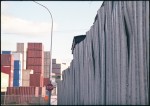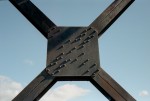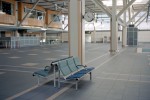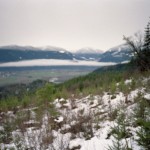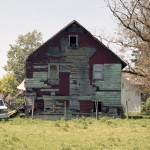Feb
1
2015

I’m going to try to have a look at this camera in a more objective fashion and separate its performance from its somewhat cult status. My first objective though was to test that it worked and for that I used some dubious outdated film. That may not have been the greatest decision I ever made. While the images turned out it left me with the question of whether or not the camera meters accurately because both rolls of film I used ended up being very contrasty. For both rolls I shot under dark rainy conditions as well. It’s not all doom and gloom though the camera worked well and earned the right to have some decent film next time.
One thing about one camera: The T4 Super was available in 1993 for $129.90 today it sells on Ebay for around twice that much. One of the few point ans shoot cameras that actually went up in value. I have no intention of ever selling it though as I consider it a gift. Why Photography Makes you a nice person
1 comment | tags: film, Yashica | posted in Cameras, Photography
Oct
9
2014
It was a last-minute decision to go inside a thrift store as I drove by on my way home from the library my front seat so laden with photography books the airbag system probably registered there was an adult sitting there. I had been in that store before never finding any cameras that I really wanted or felt I needed. This time though I came across a great looking Olympus Stylus Epic. My new find in hand I went over to the glass counter to see if there were any more to be had. As I waited for someone to assist me a gentleman walked up nearby I could see he too had a camera he was going to purchase. It had that champagne colour that screams ‘this is from another decade past’ I thought poor fellow he has a Minolta Big Finder or something similar while I have an Epic. I guess he saw my camera too because he came over to say hello and we exchanged the secret handshake that only camera collectors know. I could see besides his nice jacket and carefully chosen glasses he had a well-worn canvas camera bag and it was then that I also saw that it wasn’t some 1990’s cast away camera he had but a Yashica T4 super. A desirable model of camera which I had never seen in person before. I must have been extremely excited because after we determined that we knew of each others blogs and shared an interest in cameras he handed me the Yashica with a ‘I want you to have this’ I think I was beaming the entire way home. And that is why cameras and photography make you a good person. (Okay I don’t actually have proof of that but it does prove that JJ Lee is a nice person)
JJ Lee is a writer and radio host his photography related blog can be seen here The Shutter Goes Click
So now I have a Yashica T, T2 and T3 and to finish it off the Yashica T4 Super Weatherproof all fitted with their fantastic Carl Zeiss lenses. I can hardly wait to start shooting with my new camera.

1 comment | tags: Yashica | posted in Cameras, Photography
Aug
5
2013

The Yashica T3 is one of those cameras that you tend to keep coming back to using because of the lens. I haven’t been able to definitely pinpoint what sets the look of the images from this camera apart but I know I like the results. It’s not always easy to convey that through small web images and these look a little soft as I post them but the originals are not.
no comments | tags: camera, film, Photography, Yashica | posted in Cameras, Photography
May
7
2013

Using a half frame camera gives you 48 pictures from a regular 24 image roll. It’s very freeing to have all those extra pictures but not crazy like digital. I was shooting this roll of film to create in camera diptychs and these are just the images that were not in pairs. Yes I know there is a fiber that shows up at the edge of all the images, someone should really do something about that.
1 comment | tags: camera, film, Yashica | posted in Cameras, Photography
Apr
18
2013
Taking two pictures that go together is an added challenge that I enjoy. Sometimes it works and sometimes it doesn’t. I tried this previously here Diptychs also using the Yashica Samurai because it’s half frame and runs the film vertically like a movie camera. This allows images to be stacked right on the negative. This is different from almost every other 35mm camera of course because their film runs horizontally through the camera.
As I wrote on a napkin previously you need to take the lower image first because of the way the film travels and the inversion of the image through the lens.
3 comments | tags: Diptych, film, Yashica | posted in Cameras, Photography, Processing
Apr
14
2013

If I were shipwrecked on a desert island and I could only have one camera it wouldn’t be the Yashica Electro 35GX. Why? I couldn’t bring myself to break it to use the lens to start a signal fire of course. Of all the fixed lens 35mm rangefinders this must be one of the best, I don’t know of one better. Every time I get negatives back from this camera I am pleased, the images are sharp and the way the lens renders the out of focus areas is smooth and delightful. I also like the 40mm focal length, it may be the Goldilocks between 35mm and 50mm. As an example of the sharpness of the lens and just how fine grained Kodak Ektar is here is a 100% crop from one of the images.

Scanned at 3200 DPI the resulting file is about the equivalent of a 13 mpixel digital capture. Not bad and films ability to preserve shadow and highlight detail in the same image still exceeds digital for now but that’s not really why I shoot film. It’s still all about the cameras for me and this one is great.
More images and information I have written about this camera can be found here Oct 2012 and here Cross Processed Velvia and Canon Ql17 vs Yashica Electro GX there are more so maybe using the search function on my blog is a better idea.
no comments | tags: camera, film, Yashica | posted in Cameras, Photography
Jan
30
2013

I had hoped for better results from the Yashica T AF with its 35mm Carl Zeiss T* optics but I was unfortunately let down by the focus system. My copy no longer focuses to infinity. The reason for my optimism came from several factors beyond the lens; It has a manual ASA setting that can by easily used as a rudimentary exposure compensation system, it only fires the flash when you activate it rather than defaulting to on like so many other point and shoot cameras including the fantastic Yashica T3. Aesthetically I like the camera too for its angular glossy plastic and smoked glass lens cover that swings away to reveal the lens for each exposure, this all seems like it could only have sprung from the early 1980’s.
Back to my copy of this camera, only where I pointed the camera at nearby objects did it achieve correct focus, so all the shots into the distance are out of focus. Oh well I will mark the camera with a tag of shame and put it into the parts bin.
5 comments | tags: film, Yashica | posted in Cameras, Photography
Nov
28
2012
Some film shots from my Yashica GX in October 2012. Amoung the images is one of Copp’s shoes which will be closing at the end of December after 87 years.
1 comment | tags: film, Photography, Yashica | posted in Cameras, Photography
Jun
19
2012


I was graciously given the Yashica Samurai by a friend who recognized that it would interest me, and it does. It’s a half frame camera producing 50 negatives from a standard 24 exposure roll of film. That itself is interesting, it makes you feel less encumbered by the preciousness of the film. It feels almost like shooting digitally you have so many exposures available. Then there is the form of the camera, which is somewhere between an old video camera and a…..I got nothing it’s between an old video camera and nothing. It is an actually SLR with a mirror and a direct view through the lens but rather than the film travelling horizontally the film travels vertically like it would in a movie camera. This provides the opportunity to create vertical stitches of images on the film which I will cover in a later post. The lens is a 25 to 75mm zoom which because of the half frame nature of the camera translates into a 35mm equivalent of 35 to 105mm. Despite being an SLR the camera doesn’t allow manual control or overide of the exposure so it’ functions more like any other point and shoot film camera that looks like a video camera from 1993.
2 comments | tags: film, Yashica | posted in Cameras, Photography, Uncategorized
Jun
16
2012
When you capture images on film they are connected to neighbouring ones by their position on the substrate, where a digital file is on it’s own, easily orphaned or separated. That’s all a bit overly dramatic what I should say is that it’s fun to take images on film that are meant to exist together and this is harder to do on film than bringing them together after the fact as you would with two digital pictures. As this is the first time I have used the half frame Yashica Samurai it didn’t always work out but you learn from doing. My first error was miscalculating the field of view of the viewfinder. I framed the images that were supposed to go one on top of the other as if the viewfinder provided a 100% view, it does not. So the result is that rather than being a seamless image formed from two frames I have two images with overlapping content separated by a black band, that is a failure. The other mistake I made was when I turned the camera on it’s side and tried to do a multi-image panoramic. I panned in the wrong direction but I will get to that in a minute.
 What I’ve done here is scan the two half frame exposures as one image.
What I’ve done here is scan the two half frame exposures as one image.
And what follows are my attempts at creating a single image from two frames.



Now the panorama should look something like this, but with black bands between the frames, (This is from the same scanned images joined with software.) but it ended up looking like this on the negative.
but it ended up looking like this on the negative.
The reason for this is that I panned from left to right which is the opposite direction of what I should have done, illustrated on a napkin like this  If I want the sun to be above the tree and not under the ground I need to first capture the tree image and then pan up to capture the sun when the film moves in the direction of the arrow. When you turn the camera on it’s side this translates into starting on the right and panning left, oops. The good thing is there is lots of room for improvement and experimentation, particularly interesting to me is the prospect of the image pairs.
If I want the sun to be above the tree and not under the ground I need to first capture the tree image and then pan up to capture the sun when the film moves in the direction of the arrow. When you turn the camera on it’s side this translates into starting on the right and panning left, oops. The good thing is there is lots of room for improvement and experimentation, particularly interesting to me is the prospect of the image pairs.
3 comments | tags: film, photoraphy, Yashica | posted in Photography



































